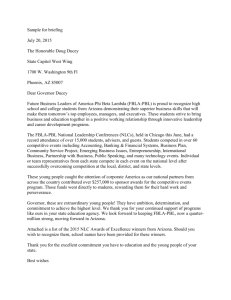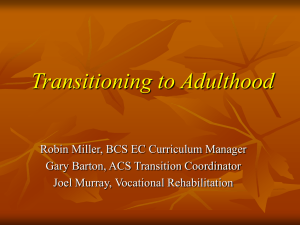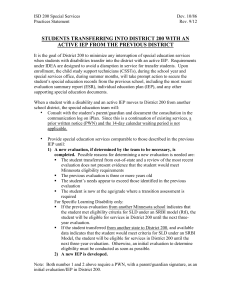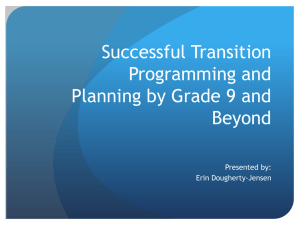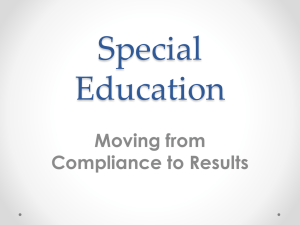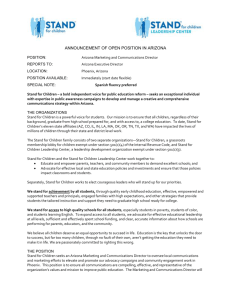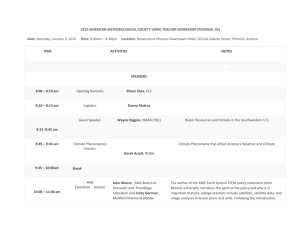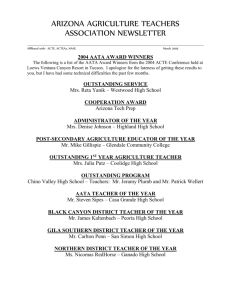Transition Point 5: Junior High/Middle School to High School
advertisement
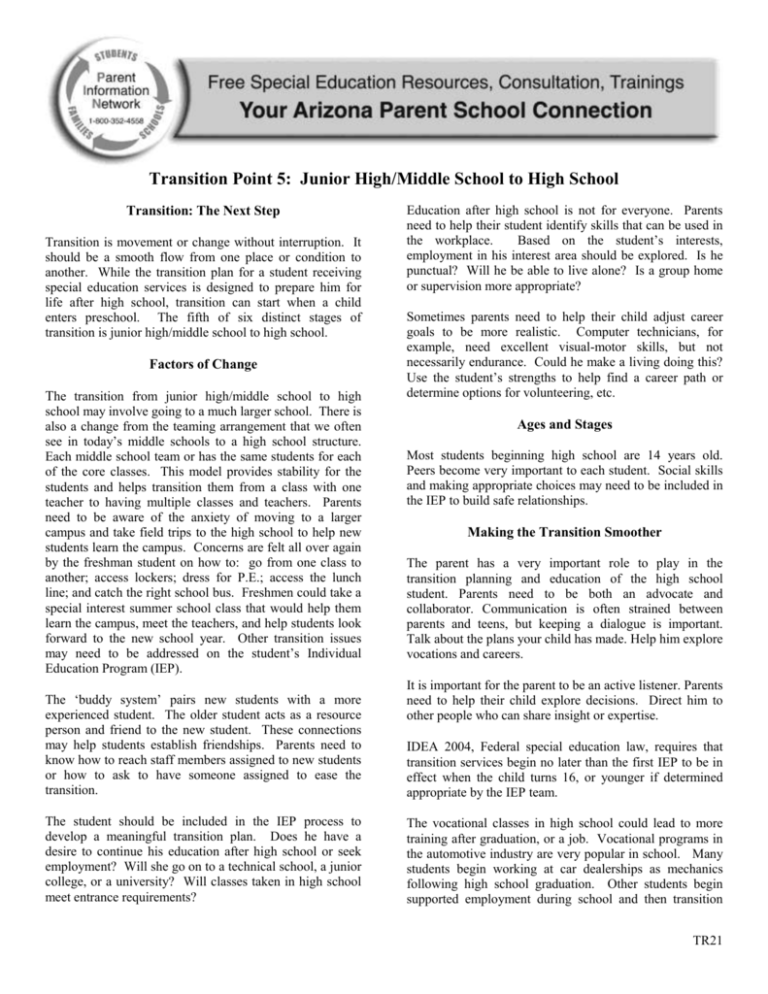
Transition Point 5: Junior High/Middle School to High School Transition: The Next Step Transition is movement or change without interruption. It should be a smooth flow from one place or condition to another. While the transition plan for a student receiving special education services is designed to prepare him for life after high school, transition can start when a child enters preschool. The fifth of six distinct stages of transition is junior high/middle school to high school. Factors of Change The transition from junior high/middle school to high school may involve going to a much larger school. There is also a change from the teaming arrangement that we often see in today’s middle schools to a high school structure. Each middle school team or has the same students for each of the core classes. This model provides stability for the students and helps transition them from a class with one teacher to having multiple classes and teachers. Parents need to be aware of the anxiety of moving to a larger campus and take field trips to the high school to help new students learn the campus. Concerns are felt all over again by the freshman student on how to: go from one class to another; access lockers; dress for P.E.; access the lunch line; and catch the right school bus. Freshmen could take a special interest summer school class that would help them learn the campus, meet the teachers, and help students look forward to the new school year. Other transition issues may need to be addressed on the student’s Individual Education Program (IEP). The ‘buddy system’ pairs new students with a more experienced student. The older student acts as a resource person and friend to the new student. These connections may help students establish friendships. Parents need to know how to reach staff members assigned to new students or how to ask to have someone assigned to ease the transition. The student should be included in the IEP process to develop a meaningful transition plan. Does he have a desire to continue his education after high school or seek employment? Will she go on to a technical school, a junior college, or a university? Will classes taken in high school meet entrance requirements? Education after high school is not for everyone. Parents need to help their student identify skills that can be used in the workplace. Based on the student’s interests, employment in his interest area should be explored. Is he punctual? Will he be able to live alone? Is a group home or supervision more appropriate? Sometimes parents need to help their child adjust career goals to be more realistic. Computer technicians, for example, need excellent visual-motor skills, but not necessarily endurance. Could he make a living doing this? Use the student’s strengths to help find a career path or determine options for volunteering, etc. Ages and Stages Most students beginning high school are 14 years old. Peers become very important to each student. Social skills and making appropriate choices may need to be included in the IEP to build safe relationships. Making the Transition Smoother The parent has a very important role to play in the transition planning and education of the high school student. Parents need to be both an advocate and collaborator. Communication is often strained between parents and teens, but keeping a dialogue is important. Talk about the plans your child has made. Help him explore vocations and careers. It is important for the parent to be an active listener. Parents need to help their child explore decisions. Direct him to other people who can share insight or expertise. IDEA 2004, Federal special education law, requires that transition services begin no later than the first IEP to be in effect when the child turns 16, or younger if determined appropriate by the IEP team. The vocational classes in high school could lead to more training after graduation, or a job. Vocational programs in the automotive industry are very popular in school. Many students begin working at car dealerships as mechanics following high school graduation. Other students begin supported employment during school and then transition TR21 to independent living within a community based program after graduation. The following are just a few examples of transition service needs that should be considered with the staff: need for career/vocational aptitudes testing; need for teachers from the junior high/middle school and high school to talk with one another, and share records and expectations. Ideally, a representative from the high school will attend the feeder elementary/middle school’s final IEP meeting for the transition planning. Provision for any peer tutors, aides, vocational education staff, or others who are to fill a transition guidance role need to be included on the IEP. Wehman, Paul, Ph.D. (2006). Life Beyond the Classroom: Transition Strategies for Young People with Disabilities. Baltimore, MD: Brookes Publishing Company. Adolescents will try their wings, not always waiting for their parent’s approval. The parents’ role cannot be underestimated in helping to make this transition a success for the student. The ultimate goal of transition is to help a student establish a healthy lifestyle and succeed in the general curriculum and life after high school. National Dissemination Center for Children with Disabilities, P.O. Box 1492, Washington, D.C. 20013, 800-695-0285 www.nichcy.org Wehman, Paul, Ph. D. (2002). Individual Transition Plans: The Teacher’s Curriculum Guide for Helping Youth with Special Needs. Pro-Ed, Incorporated. Organizations/Web Sites Learning Disability Association of Arizona, 5757 W. Eugie Avenue, Suite 1034, Glendale, AZ 85304, 623-975-4551, www.old.ldaamerica.us/affiliates/az/welcome Parent Advocacy Coalition for Education Rights, 8161 Normandale Blvd, Minneapolis, MN 55437, 952-8389000, www.pacer.org References Arizona Department of Education, Exceptional Student Services, 1535 W. Jefferson, Phoenix, AZ 85007, 800352-4558 Parent Information Network, 602-542-3852, www.azed.gov/ess/pinspals Transition Services, 602-364-4026, www.azed.gov/ess/transitionservices Arizona Department of Education, Exceptional Student Services. (1999). Connecting components of the individualized educational program. Phoenix, AZ: Arizona Department of Education. Books Arizona Department of Education, Exceptional Student Services. Transition Services. (2004) Navigating the transition highway: From tots to teens with ease. Phoenix, AZ: Author. Available from the Parent Information Network, 602-542-3852 or 800-352-4558. Next Step Development Team. (2002) Taking the next steps-a guide to help students with disabilities transition from secondary to postsecondary education. Phoenix, AZ: Arizona Department of Education. This document was developed in 1997 and revised in June 2006 by Sharon Moeller, Parent Information Network Specialist, under contract # ED050066-03, with funds allocated by the U.S. Department of Education under IDEA 2004. The contents do not necessarily represent the policy of the agency, nor should endorsement by the federal government be assumed. The Arizona Department of Education, of the State of Arizona does not discriminate on the basis of race, religion, color, national origin, sex, disability or age in its programs, activities or in its hiring and employment practices. If you have questions or grievances related to this policy, please contact the Administrative Services DAS at 602-542-3186. This document is in the public domain and may be freely reproduced in its current format. For more information, call the Parent Information Network at 602-542-3852 or 800-352-4558. TR21 2



